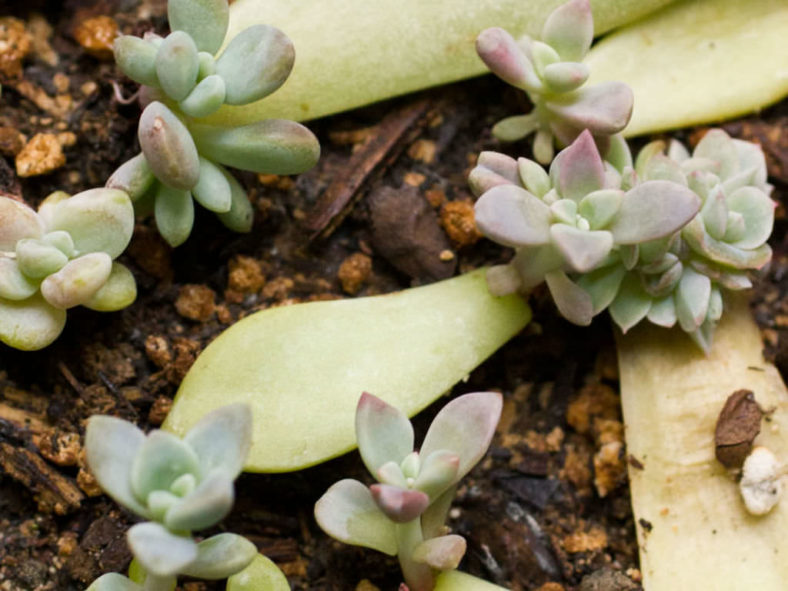Some succulents make your propagation work easier by forming new plants mostly on their own. For example, some leaf-succulents develop roots on their stems while still attached to the mother plant, and sometimes leaves fall off plants and root by themselves. Still, others develop newly rooted plantlets at their bases. For such plants, minimal effort is needed on the part of the gardener.
Root-Forming Stems
Many members of the Crassulaceae family grow prominent aerial roots along branch stems. If the branch bends over sufficiently to contact the soil, it roots into the ground at the point of contact. All you need to do is cut the connection with the mother plant, dig the new plantlet up, and give it its own pot. Some examples are Red Echeveria (Echeveria harmsii), Crinkle Leaf Plant (Adromischus cristatus), Pinwheel Plant (Aeonium haworthii), and many Kalanchoes. These plants all grow in USDA Plant Hardiness Zones 10 and 11 and can be grown as houseplants anywhere.
Leaf Propagation
Another characteristic of many Crassulaceae family plants is growing an entire new plant from one leaf. Jelly Bean Plant (Sedum rubrotinctum) grows about 6 inches (15 cm) tall with sprawling branches that root as they go. Leaves are plump, reddish-green, and the shape of a jelly bean. They turn bright red in winter. If a leaf falls from the plant, a new plant grows from its basal end. The Jade plant (Crassula ovata) does the same thing. Mother-of-millions (Kalanchoe × houghtonii) produces plantlets along the leaf margins, each growing into a new plant. It is so successful that it can become a noxious weed in Australia's areas where it is hardy. These three plants are hardy in USDA Plant Hardiness Zones 10 and 11.

Division
Succulent plants that form basal rosettes, like Aloe and Haworthia, produce new plants from the mother plant's base. The plant remains attached to the parent plant for a while, but as new offsets form, the outer plantlets become disconnected from the parent already with their own roots. You can periodically unpot the plant, remove these little independent offsets, and give them their own pot. Depending on the species, Aloes grow in USDA Plant Hardiness Zones 9 through 11, and Haworthias are hardy in zone 11.
Bulbils and Tubers
Pregnant Onion Plant (Ornithogalum caudatum), a member of the Lily family, is a stem-succulent that produces a large, pale-green above-ground bulb with a papery white covering. When the plant is 2 to 3 years old, it produces little bulbils here and there on the bulb under the papery covering. They eventually get big enough to break through the covering and fall to the ground, growing roots and forming a new plant. You can also break them off when growing their own leaves and put them on potting soil to root. Pregnant Onion is hardy in USDA Plant Hardiness Zones 9 through 11. The string of Hearts (Ceropegia woodii) forms little round tubers along its stems. Lay a stem with tubers along the potting soil, and the tubers will root into the soil. Next, disconnect the rooted stem from the mother plant to make an independent plant. The string of Hearts is hardy in USDA Plant Hardiness Zone 10.
Source: sfgate.com
Links
- Succupedia: Browse succulents by Scientific Name, Common Name, Genus, Family, USDA Hardiness Zone, Origin, or cacti by Genus